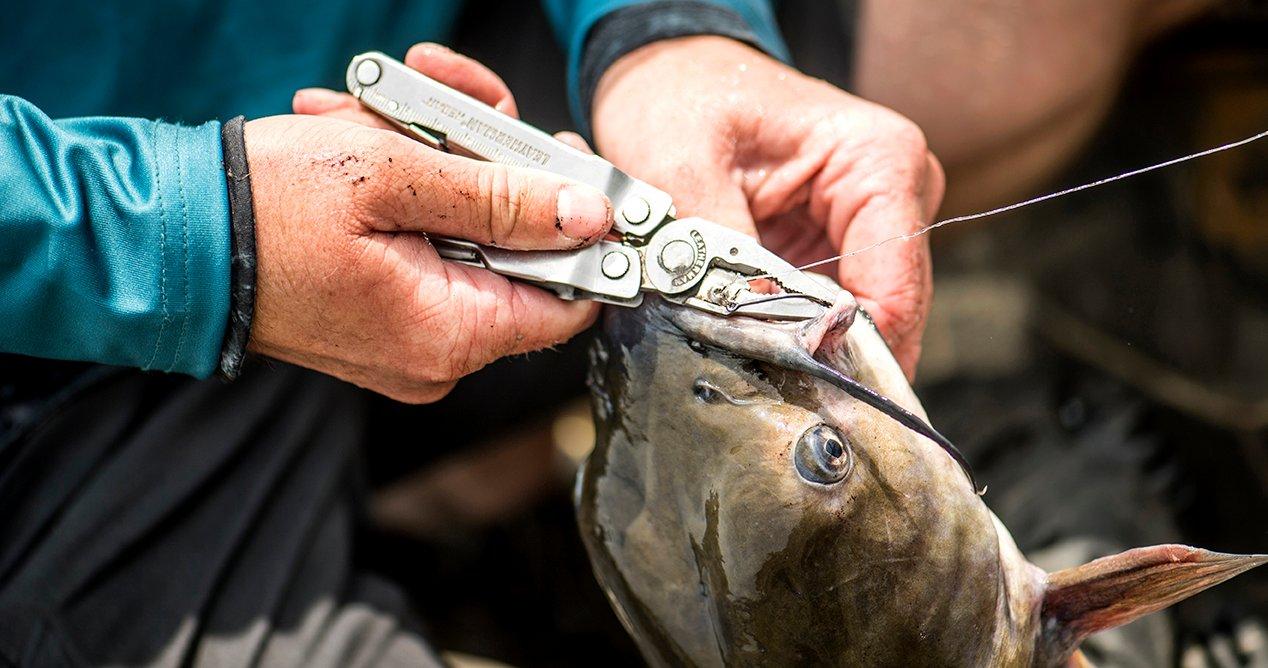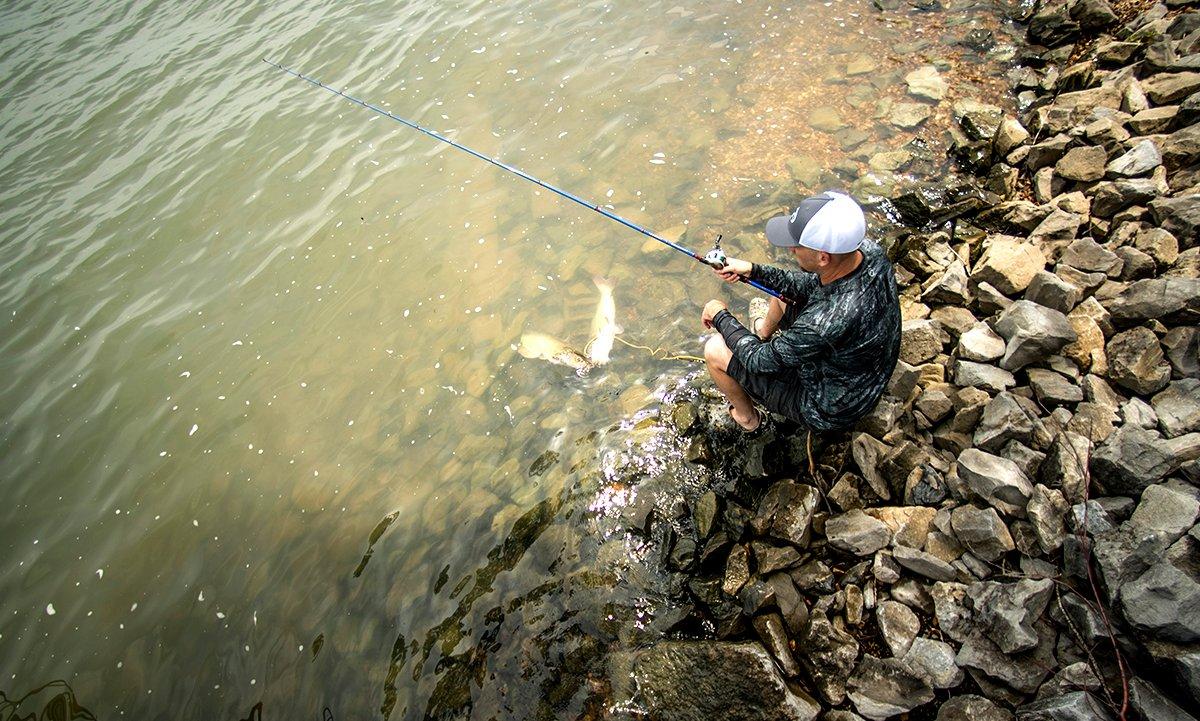Catfish are a summertime favorite, and rightfully so. They get big, fight hard and make for fantastic table fare. Catfish populations are strong in most fisheries, adding to the appeal, and they bite regularly through the warm-water months. Oh, and some of the best catfishing occurs at night, when the jet skis disappear. Finally, you don’t need a boat to go. Who’s with me?
Despite all the perks, catfishing can be intimidating for some. Hampered by the stereotype of a bottom-feeding monster looming in the darkest holes, cat-fishermen often choose improper rigs and fishing methods. They make it harder than it needs to be.
Thinking of a bank-fishing trip this summer? Want to really entertain the kids with wholesome fun, and come back with a great meal? Let’s get started.
Species Specifics
You’ll likely hear of three major catfish species across the United States: channels, blues, and flatheads. For this topic of our discussion, we’ll stick with channel cats, as they are the most numerous, inhabiting nearly every waterway, lake and swamp in the South and across the country’s midsection into Canada. Bonus: They are great to eat.
Blues are big river fish (think Mississippi), and flatheads are an outlandish predator capable of tipping 100 pounds. Both are incredible fish, and numerous outfitters specialize in trophy fishing for each. But, today, we’ll dial in the broader target: channel cats.
(Don’t Miss: Fishing Drop-Shot Rigs for Big Summer Bass)
Choose Your Location
There are two major factors here when fishing from the shoreline. One, access must be considered. Often, shoreline anglers settle in the easiest places – under and around bridges where they have a short walk to the car, or at the boat ramp or designated fishing pier. While many of the locations do, in fact, provide access to productive fishing spots, consider getting away from the crowd. Catfish populations are strong in most waters across the country, so perhaps choose a lake solely based on access, or lack thereof. The headwater areas below dams often have good shoreline fishing spots, and are known catfish honey-holes.
Or, when scouting the midsection of a reservoir, it’s hard to beat a major creek arm, specifically on shorelines bordered by bluffs. The outside bends of rivers and streams fill the same niche, as each brings deep water close to the bank. The same deep-water dropoffs are often found around causeway and spillway areas on ponds and lakes as well.
(Don’t Miss: How to Crappie Fish from the Bank)
Our goal is to have multiple depth options within casting distance, and some water flow if possible. Relatively deep water adjacent to shallows mixed with brush, rock or weeds is ideal too.
Rig Up Right
Here’s where most anglers make a mistake. First, it’s important to consider that a catfish is a predator, just like a bass. I can’t count the number of cats I’ve caught on spinners and crankbaits while fishing for bass and walleye.
For that reason, don’t make the mistake of fishing a heavy, solitary bait, waiting for catfish to smell it out. In short, the biggest mistakes most catfish seekers make are using a weight that’s too heavy and a hook that’s too big.
The biggest mistakes most catfish seekers make are using a weight that’s too heavy and a hook that’s too big.
Where current is moderate, drifting baits is extremely productive for catfish. Start with a slip float set to keep your bait a foot or so above bottom. Use a few split shots to keep the float straight. A bait-keeper or octopus hook help finish out this rig. Anything around a size 1 hook will work. Then just start with plain old nightcrawlers for bait. Drift the worms down steep shorelines, around flooded trees, or along riprap banks.
Let’s take a minute to talk bait – another topic often overdone in the catfish world. Sure, secret concoctions may up the odds for hardcore tournament anglers, but sticking to the basics will put fish on the stringer and eliminate confusion. As mentioned, nightcralwers are hard to beat. Chicken livers are a known winner, but have a tendency to fall off the hook more easily. Cut bait – especially the types of fish in your local lake – can be dynamite. Crawfish work, as do shrimp at times. Experiment. Catfish will eat all, but frequently show a preference.
- Quick tip: Carry a small cutting board and sharp bait knife to prepare choice cuts on site. It’s possible to catch most of the best bait with a cast net right at the fishing area.
Bottom rigs are a staple in catfishing, and should be part of your arsenal every day. But, again, don’t overdo it. A bottom rig should consist of a sinker only strong enough to hold bottom given your conditions. In the calm waters of a farm pond, a few small split shots will work. Heavy current may require weights of a couple ounces.
Sliding sinker rigs allow catfish to take a bait without resistance. Three-way swivel rigs keep the bait fixed, and are better at keeping it from washing away in heavy current. Choose your rig based on flow.
Again, use a fairly small single hook. Besides the octopus models, I’ve had great luck with a 1/0 Kahle hook on a three-way rig when fishing heavy current below dams. Baited with a piece of cut shad – or sucker for friends up North – this rig is money.
(Don’t Miss: 16 Years of Noodling for Catfish)
Rods and Reels
Again, let’s tone it down a bit. Many diehard catfish anglers use very large equipment, as they specialize in big fish and heavy current. For our fishing, bass rods will suffice. Medium powers and actions work well, but it’s best to choose a fairly long rod, as it will aid in casting and getting more line off the water when fishing from a fixed position. This helps eliminate line drag from current.
Baitcasters prevail, but spinning gear will work. For float and lightweight fishing, spooling up with 12-pound test should work. Braided line can help, but be sure to use a long leader from your float to the hook.
For heavier bottom rigs, it’s best to have a main line around 20-pound strength. Braid works here, too. On a three-way rig, kip your dropper line (with the sinker) lighter than the rest in case you need to break off.
Having a high-visibility main line greatly aids in strike detection. Some companies make lines that show up well at night, too.
- Quick tip: Take a rod holder with you, rather than relying on the old forked stick method. I carry PVC holders intended for beach fishing, and find them to be lifesavers, keeping my rod stable and high.
When to Hold, When to Fold
More about catfish: Don’t think for one minute that they’re sleeping during the day and lurking slowly at night. These fish are active predators. If you’re not getting bites, you’re not on them! While there is some validity in waiting it out, a bump-and-run method usually prevails, as cats inhabit the best feeding areas. Fish multiple rods at multiple depths. Give it an hour or less, and move.
Nighttime anglers tell of active feeding periods, as these seem to be more apparent in catfish than many other freshwater gamefish. Often, a window opens with tremendous action midway through a session. Take note that best fishing usually occurs just before dusk, and then a few hours after dark. If you fish through both of these sessions without much luck, it’s time for a move.
A nice thing about catfish: Once you find a productive area, it usually holds up through the summer.
(Don’t Miss: The 3 Biggest Catfish Ever Caught)
A Note on Fish Handling and Care
Catfish get a bad rap for their strong fin spines. Yes, they will stick you if you grab haphazardly, but the fish aren’t out to get you. Play the fish down a bit. Then get a firm grasp behind the side and top fin spines and all will be well.
Always carry pliers in your tackle box. Catfish have very strong jaws, and getting a hook out is much easier with the right tool.
Most anglers place their fish on a stringer. That works, but immediately icing fish is always best. And don’t underestimate the amount of ice a catfish will melt after being caught in 90-degree water.
Cleaning catfish is another intimidating part of the sport, but greatly exaggerated. The traditional way involves skinning the fish with pliers; however, catfish can be filleted and skinned like nearly every other fish. The secret lies in having a very sharp fillet knife. Also, getting the feel for working around the rib bones is a bit of a challenge at first, but quickly becomes second nature. Youtube provides dozens of tutorial videos on cleaning catfish.
Catfish are truly one of the best-eating fish in freshwater, and their mild taste remains even in the warmest waters.
Bank fishing for catfish is a summer tradition for many. It presents everything that’s good about the sport — peace and quiet, time with friends and family, and a great meal after the game. Best yet, you don’t need to fill a boat with gas. Don’t let the season slip by without giving it a shot.
















